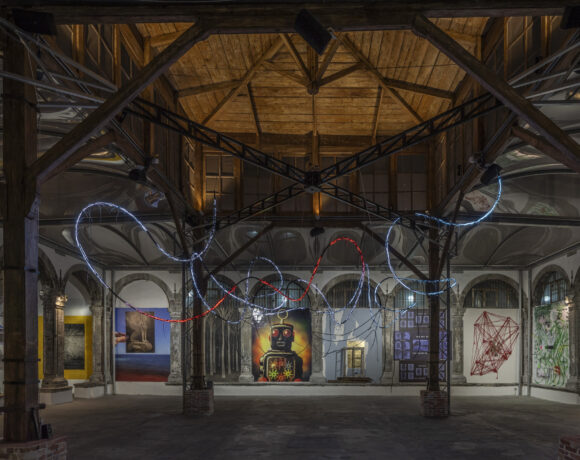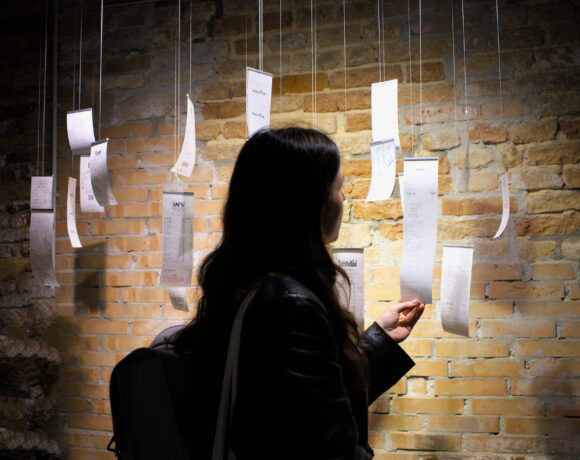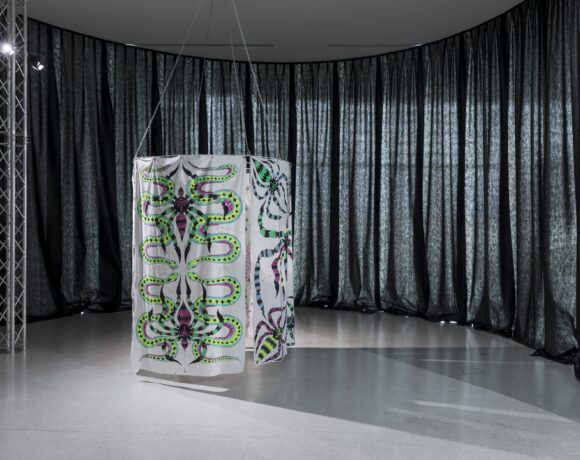It is the evocative setting of Spazio Taverna – directed by Ludovico Pratesi and Marco Bassan – to host Reazioni. Antidoti ironici (“Creactions. Ironic antidotes”) from December 17th 2021 to January 14th 2022. The exhibition, curated by Luiss Business School Master of Art collective and now in its eleventh edition, wanted to focus on irony as a device of reaction towards the in multiple solicitations contemporaneity calls us to face.
Within the three rooms of the space, the 13 artists selected by the Luiss collective, including the 3 finalists of Premio Generazione Contemporanea (Amedeo Polazzo, Diego Cibelli, Antonio della Guardia) formalize their reflections on the theme by offering them to the an active audience. It’s the collective that clearly indicates, in the catalogue editorial, the winning approach to the exhibition: “we want to entice you to react, but we will also be ready to accept your indifference”. While wishing to grant indifference its own dignity, the writer strongly believes that a proactive attitude is the best homage to the chosen theme. And if the journalist can accept the provocation of the editorial with the methods and tools that belong to him – words – the artist will always let his works speak. Each reaction, therefore, is in art a creation; iconic, as well as ironic, will then be the antidotes with which artists respond to the poisons of the present.
At this point, a question appears legitimate: if irony is the antidote, what are the toxins that contaminate today’s society? From homophobia, exorcised in Ruben Montini’s fabrics (LAME, 2020-21) to racism (Alterazioni Video, Black Rain, 2010), it is the role of art and culture professionals within the community that is repeatedly questioned.
Marzia Migliora (Con la cultura non si mangia) prepares an inadmissible banquet of clichés. Firmly rooted in the popular imagination, the cliché that relegates culture to the subset of the unproductive, finds an “official” dimension in the unfortunate statements of some well-known exponents of the national political panorama. It was Giulio Tremonti, at the time (2013) Minister of Economy and Finance in Italy, who launched the anathema that gives the work its name and seems to have lost little or nothing of its original effectiveness. The politicians’ phrases are collected by the artist who reports them, screen-printed, on a set of 12 majolica plates and bowls that becomes the epicenter of a process with a strong relational charge.
Such a participatory component seems to belong, in the adjacent room, even to Jonathan Vivacqua’s Lavoro inutile. With Vivacqua, inanity, no longer confined to artistic work, borders on involving the actual working practice, which in this case, starting from four hundred scrap microcubes in reinforced concrete – candies – creates a square mosaic. The uselessness of such a product is reaffirmed, in addition to the title, by the possibility, contemplated by the artist, that this “carpet” will be walked, trampled on by the spectators and by the recovery, also apparently useless, of the slow rhythms of the mosaic practice.
With How to teleport a Furby, perfettipietro stages the two-act drama of the disappearance. Pressed by the etiquette, by the submission to social obligations of all kinds, the creative part of each of us is destined to disappear (CTRL + X is the formula used in computer science to cut a part of text) to “teleport” (CTRL + C and CTRL + V, or copy and paste) in an elsewhere purified by the codes, where “by reaction” one can “choose not to be anything”.
If the Furbys are here to remind us how “by closing our eyes […] it is still possible to project ourselves into that dreamlike space that nestles within us”, Antonio della Guardia (PER UN PROSSIMO REALE # 5) tries to hinder the widespread illiteracy of vision “in a historical moment in which the community is constantly subjected to a media bombardment of images”. With PER UN PROSSIMO REALE #5, which is also the winning work of Premio Generazione Contemporanea, a call launched by the Luiss Business School that allows the winning work to become part of its permanent collection, della Guardia proposes a series of paths, embroidered with gold thread on a large blue velvet cloth, which simulate the flight paths of some insects and birds.
With Gino Perdonami and Alighiero Perdonami, Daniele Sigalot openly takes a mockery of today’s art system. Specifically, his controversy seems to be aimed at the entire sector of criticism. When questioned about irony, for the artist the latter takes on the appearance of a “bomb disposal with a clown nose who tries to defuse the pomposity that envelops the world of art like a burrito”. The two aluminium large post-its hide, behind the apparent banality of their truisms, the modus operandi of a certain part of art criticism, always on the hunt for “big names” who in a certain sense “legitimize” the validity of an artwork. By bothering two sacred monsters of the contemporary, in fact Sigalot asks forgiveness for the sins of others.
Calling attention to what Goethe said, Bonito Oliva spoke of irony as a “passion released in detachment”. And it is such an awareness of this distance, for the writer, that constitutes the obligatory starting point for any mature reflection on irony. Detachment of the artist from the “passion”, but, above all, detachmente of the public from the work. If any claim of slowing down the hyperproduction of visual stimuli appears anti-historical, a new literacy of the act of vision appears more realistic, to give the due weight to irony – which is abused today – in the “next real” we are called to build.
Info:
Reazioni. Antidoti ironici (Creactions. Ironic antidotes)
curated by Luiss Business School Master of Art XI
Spazio Taverna
Via di Monte Giordano, 36, 00186 Roma (RM)
17/12/2021 – 14/01/2022
admission by reservation
info: https://reazionimasterofart.wordpress.com/
 Marzia Migliora, Con la cultura non si mangia, installation view, 2013-2021. Set of 12 plates and 12 bowls, white majolica, handcrafted on a lathe, with screen printing, Ø 26 cm, Ø 15 cm. Courtesy: the artist; Lungo Mare, Bolzano; Galleria Lia Rumma, Milano/Napoli © Giulia Pontoriero
Marzia Migliora, Con la cultura non si mangia, installation view, 2013-2021. Set of 12 plates and 12 bowls, white majolica, handcrafted on a lathe, with screen printing, Ø 26 cm, Ø 15 cm. Courtesy: the artist; Lungo Mare, Bolzano; Galleria Lia Rumma, Milano/Napoli © Giulia Pontoriero
 Jonathan Vivacqua, Lavoro inutile, 2019, mosaic, 150 x 150 cm. Courtesy: White Noise Gallery © White Noise Gallery
Jonathan Vivacqua, Lavoro inutile, 2019, mosaic, 150 x 150 cm. Courtesy: White Noise Gallery © White Noise Gallery
 perfettipietro, How to teleport a Furby (dettaglio), installation view, 2021. Mixed media, 17,5 x 74 cm (CTRL+C e CTRL+V); 22 x 84,5 cm (CTRL+X); 16 x 12 cm (Furby). Courtesy: Spazio Display © Giulia Pontoriero
perfettipietro, How to teleport a Furby (dettaglio), installation view, 2021. Mixed media, 17,5 x 74 cm (CTRL+C e CTRL+V); 22 x 84,5 cm (CTRL+X); 16 x 12 cm (Furby). Courtesy: Spazio Display © Giulia Pontoriero
 Antonio della Guardia, PER UN PROSSIMO REALE #5, 2021, embroidery with golden thread on velvet, 550 x 160 cm, steel support 275 x 210 x 60 cm. Courtesy: the artist, Galleria Tiziana Di Caro © Roberto Apa.
Antonio della Guardia, PER UN PROSSIMO REALE #5, 2021, embroidery with golden thread on velvet, 550 x 160 cm, steel support 275 x 210 x 60 cm. Courtesy: the artist, Galleria Tiziana Di Caro © Roberto Apa.
 Daniele Sigalot, Alighiero perdonami; Gino Perdonami, installation view, 2021. Acrylic paint and oil pastels on aluminum, 70 x 70 cm. Courtesy: Wetzel & Magistris © Giulia Pontoriero
Daniele Sigalot, Alighiero perdonami; Gino Perdonami, installation view, 2021. Acrylic paint and oil pastels on aluminum, 70 x 70 cm. Courtesy: Wetzel & Magistris © Giulia Pontoriero

Graduated in Conservation of Cultural Heritage, he is currently attending the master’s degree course in Visual Arts at the University of Bologna. He is part of the team that manages a well-known cultural dissemination blog and is also a contributor for Juliet Art Magazine. He believes in art as a space for recovering a lost complexity.






NO COMMENT